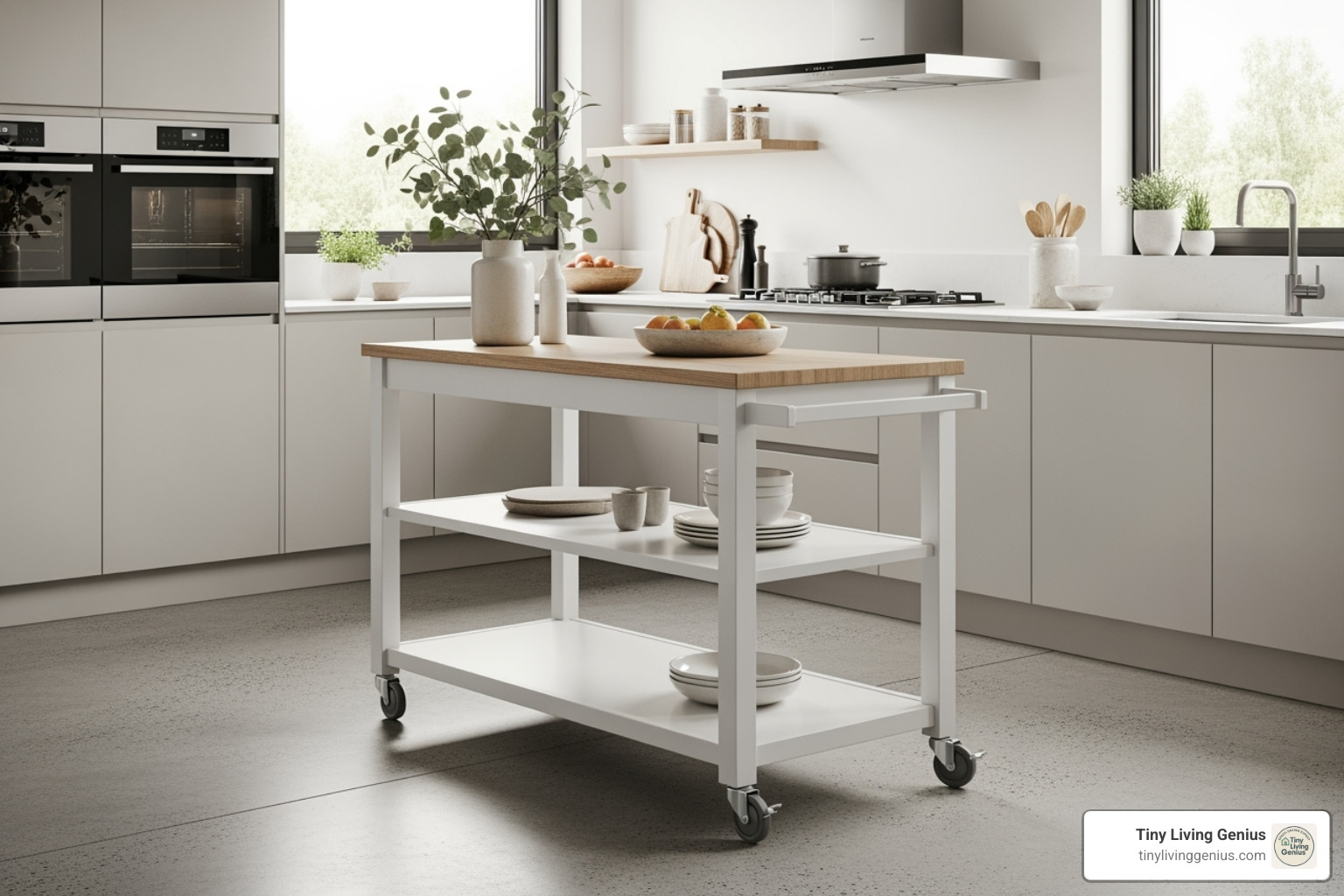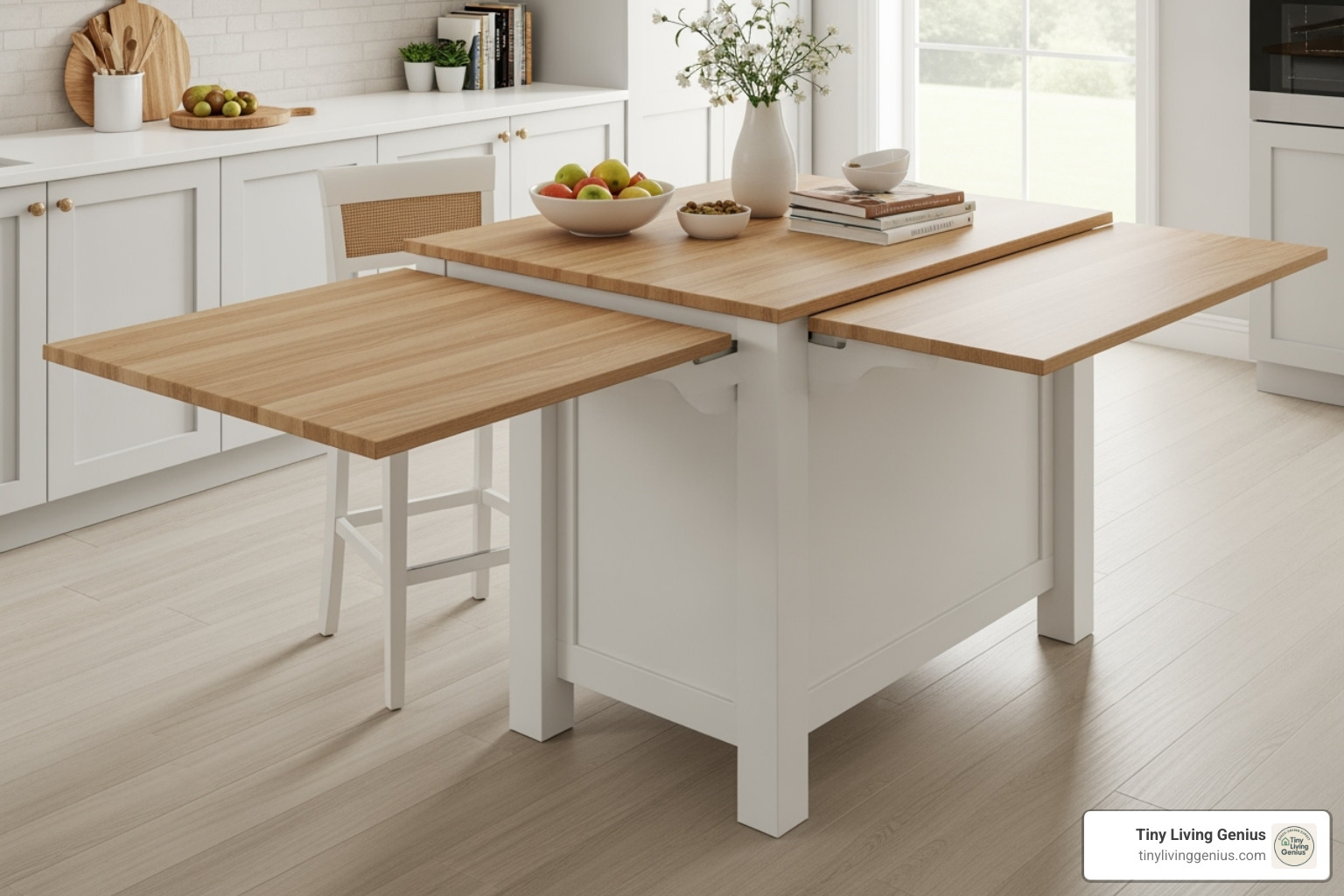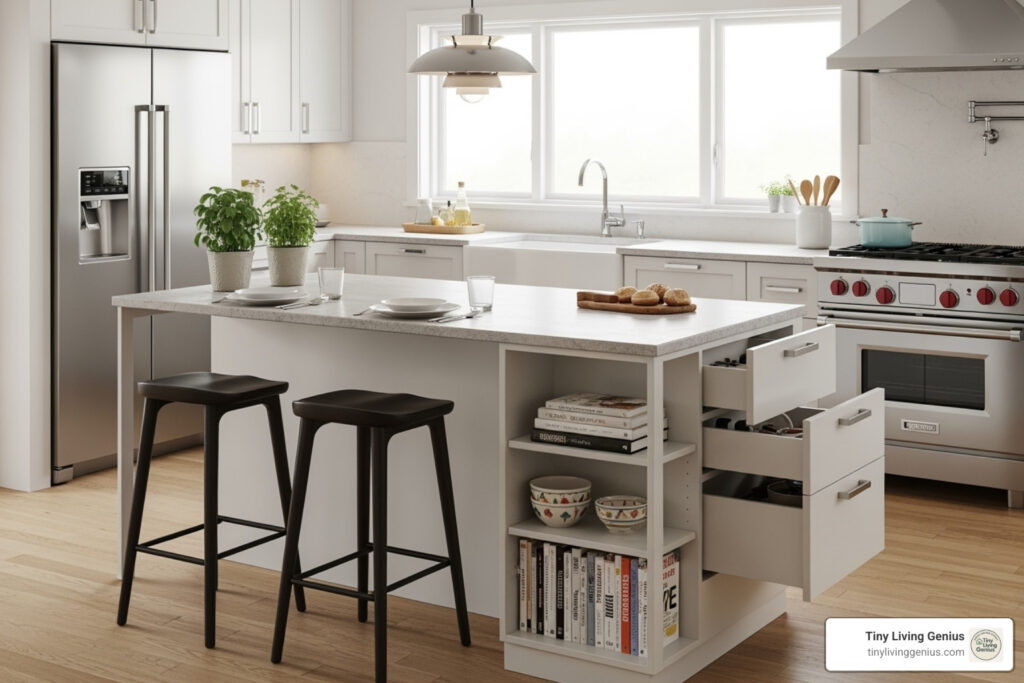Small Kitchen Table Island: 3 Smart Solutions
Why a Small Kitchen Table Island is the Ultimate Space-Saving Solution
A small kitchen table island can transform your cramped cooking space into a functional, stylish hub. Here’s what you need to know:
Key Benefits:
- Extra Prep Space – More room for chopping, mixing, and meal prep
- Added Storage – Shelves, drawers, and cabinets keep essentials organized
- Flexible Dining – Doubles as a breakfast bar or casual eating spot
- Improved Flow – Defines zones in open layouts without blocking movement
Best Types for Small Kitchens:
- Rolling Carts – Mobile and easy to tuck away
- Drop-Leaf Islands – Expand when needed, fold down to save space
- Narrow Stationary Islands – Permanent solution with built-in storage
If you’re living in a small apartment or studio, you know the struggle. Counter space vanishes the moment you start cooking. There’s nowhere to sit for a quick meal. And every surface is cluttered with utensils, appliances, and groceries fighting for space.
The dream of a spacious kitchen island might feel impossible when you’re working with limited square footage. But here’s the good news: a small kitchen table island offers all the benefits of a full-sized island without overwhelming your space.
These compact, multi-functional pieces add precious prep space, create hidden storage, and even provide a spot to enjoy your morning coffee. Whether you choose a rolling cart you can move on demand, a drop-leaf design that expands for guests, or a narrow stationary island with built-in drawers, you’re gaining functionality without sacrificing flow.
Small kitchen islands aren’t just practical—they’re style statements. They help define zones in open-plan layouts, anchor your kitchen’s design, and create a natural gathering spot for family and friends. For more ideas on maximizing functionality in tight spaces, check out our guide on Creative Ideas for Small Space Furniture: Maximizing Functionality in Small Spaces.
I’m Ramy Saber, and as a Civil Engineer and founder of Tiny Living Genius, I’ve spent years helping people find smart solutions for compact living, including the perfect small kitchen table island for every layout and budget. In this guide, I’ll walk you through the best options, features to look for, and how to choose the right fit for your space.

The Big Benefits of a Small Footprint
Here’s the truth about small kitchens: every single inch counts. And that’s exactly why a small kitchen table island isn’t just nice to have—it’s a total game-changer.
When you’re working with limited square footage, you might think an island is out of reach. But the right compact island actually solves more problems than it creates. Let’s talk about how these clever pieces transform cramped cooking spaces into efficient, enjoyable places to make meals and memories.
The most obvious win? Added counter space. In tiny kitchens, countertops disappear fast. You’ve got the coffee maker here, the knife block there, and suddenly there’s nowhere left to actually cook. A small island gives you a dedicated spot for chopping vegetables, rolling out dough, or staging ingredients before they hit the pan. This extra surface makes cooking feel less like a juggling act and more like something you actually want to do. Imagine spreading out your cutting board without playing Tetris with your appliances first.
Then there’s the increased storage that most islands bring to the table (pun intended). Many models pack in drawers, shelves, or cabinets that turn wasted floor space into prime real estate for pots, pans, mixing bowls, or those small appliances you use just often enough to keep around. Some designs feature open shelving perfect for tucking attractive baskets underneath—great for hiding dish towels or pantry overflow. Others include enclosed cabinets with a clever gap at the bottom where backless stools can slide completely out of sight when not in use. This kind of integrated storage is gold when you’re trying to keep a small kitchen from looking cluttered. For more ways to maximize what you’ve got, check out our guide on Smart Storage Solutions for Small Spaces.
But here’s where small islands really earn their keep: they create a flexible dining area when you don’t have room for a full table. A simple overhang with a couple of stools transforms your island into a breakfast bar, lunch spot, or dinner for two. In a studio or tiny apartment, this dual-purpose setup means you’re not choosing between cooking space and eating space—you get both. It’s the kind of multi-functional thinking that makes small space living actually work.
A well-placed island can also give you improved kitchen workflow. By creating a central work zone, it shortens the distance between your sink, stove, and fridge—that classic “work triangle” professional kitchens rely on. Less running back and forth means cooking feels smoother, faster, and frankly, more fun.
And if you’re dealing with an open floor plan, a small island is brilliant for defining zones without putting up walls. It creates a natural boundary between your kitchen and living area, giving each space its own identity while keeping everything open and connected. This subtle separation makes the whole area feel more organized and intentional, not just one big room with stuff scattered everywhere.
Finally, there’s the social side. A compact island becomes a natural hub for entertaining. Guests can gather around with drinks and appetizers, chatting while you finish up dinner, without crowding you out of your own cooking space. It’s that perfect sweet spot where hospitality meets functionality—and in a small home, that balance is everything.
Types of Small Kitchen Table Islands to Maximize Your Space
The beauty of today’s small kitchen table island options is that there’s genuinely something for every space and lifestyle. Whether you need ultimate flexibility, occasional extra surface area, or a permanent fixture that anchors your kitchen, the right island is out there waiting to transform your compact cooking space.

Rolling Carts: The Ultimate Flexible Small Kitchen Table Island
If you’re someone who loves options, a rolling cart might just become your new best friend. These clever little islands move wherever you need them, offering a level of mobility that’s hard to beat in a small kitchen.
Picture this: you’re prepping dinner and need extra space near the stove. Roll your cart over. Hosting friends and need a drink station in the living room? Roll it there. Want to reclaim your floor space for yoga or just to make the room feel bigger? Tuck it against the wall. This portability makes rolling carts absolutely ideal for tiny kitchens where every square foot counts and flexibility is key.
The secret to a good rolling cart is locking casters. These little wheels lock in place when you need stability for chopping or kneading, then open up when it’s time to move. You get the best of both worlds—mobility when you want it, stability when you need it.
Rolling carts come in beautiful wood and metal options that can match any style. A butcher block top adds warmth and provides a durable, knife-friendly surface that gets better with age. Some designs feature open shelving perfect for displaying your favorite cookbooks or storing everyday essentials within easy reach.
Restaurant-style rolling islands with sturdy countertops and open metal shelving offer serious functionality at reasonable prices. And if you’re the DIY type, you can even create your own from simple materials or repurpose existing furniture with a set of casters. For more inspiration on making the most of limited square footage, explore our Tiny Space Solutions.
Drop-Leaf Designs: The Expandable Small Kitchen Table Island
Sometimes you need a little more surface area, but not always. That’s where drop-leaf islands shine—they’re the ultimate “have your cake and eat it too” solution.
These genius designs feature hinged leaves that fold up when you need them and fold down when you don’t. It’s like having two islands in one. Need extra workspace for a big cooking project? Lift the leaf. Want to create a dining area for two or more? Extend the surface and pull up some stools. Done with dinner and need to move around freely? Fold it back down.
This expandable surface is perfect for kitchens that need to adapt throughout the day. Maybe it’s a compact prep station during the week, then transforms into a brunch spot on lazy Sunday mornings. The fact that it folds down when not in use means you’re never sacrificing precious floor space for features you’re not currently using.
Drop-leaf islands are also perfect for entertaining. When guests arrive, simply lift the leaf and suddenly you have room for appetizers, drinks, or a casual buffet. It’s an instant gathering spot that disappears when the party’s over. For more furniture that adapts to your changing needs, check out our 10 Foldable Furniture Ideas for Small Apartments.

Narrow & Stationary Islands
If you prefer something more permanent, a narrow stationary island offers stability and substance without overwhelming your space. These islands stay put, becoming a reliable cornerstone of your kitchen layout.
Don’t assume islands won’t work in tight quarters. Even in galley kitchens, a narrow stationary island can fit beautifully—some designs are just one cabinet deep, leaving plenty of room for comfortable movement on both sides. This gives you permanent prep space that’s always ready when you need it.
The real magic happens with built-in storage. Stationary islands often feature drawers and cabinets that integrate seamlessly with your existing kitchen, creating a cohesive look while hiding away pots, pans, and cooking essentials. Some designs mix closed storage with open shelving, giving you both concealed space for clutter and display areas for beautiful dishes or cookbooks.
Even narrow islands can include a seating overhang that accommodates a stool or two. This creates a cozy breakfast bar or a perch for guests to sit and chat while you cook. It’s amazing how much functionality you can pack into a slim profile.
Here’s where it gets really interesting: some compact stationary islands can house sinks or cooktops, changing them into true workstations. Imagine having a small prep sink in your island, or an induction cooktop that turns it into an active cooking zone. This level of integration brings serious functionality to even the smallest kitchen, proving that size doesn’t limit what’s possible.
These thoughtful designs embody everything we believe in at Tiny Living Genius—they’re perfect examples of Efficient Design for Small Spaces: Stylish Living Solutions for Small Spaces.
Choosing the Perfect Fit: Size, Style, and Materials
Finding the right small kitchen table island is a bit like dating—you need chemistry, compatibility, and the right fit for your lifestyle. It’s not just about falling in love with a pretty face; it’s about making sure it actually works in your space and improves your daily life. Let’s talk about how to choose wisely.

Sizing and Placement
Here’s where dreams meet reality. You might have your heart set on a gorgeous island, but if it doesn’t fit your kitchen properly, it’ll become an expensive obstacle course rather than a helpful addition.
Start by measuring your kitchen thoroughly. Grab a tape measure and map out the open floor space where you envision your island living. Don’t just measure the empty space—think about how cabinet doors swing open, where your refrigerator door extends, and how the dishwasher opens. These everyday movements matter more than you might think.
Now, let’s talk about the magic number: 40 inches of clearance. This is the recommended minimum space you should maintain around your island on all working sides. Think of it as your kitchen’s breathing room. This clearance allows you to walk past comfortably, lets appliance doors open without playing kitchen Tetris, and means two people can work simultaneously without doing an awkward dance around each other. While full-sized islands can be over 55 inches wide, your small kitchen table island needs to respect this clearance rule to truly earn its place in your compact space.
Proportionality is your friend here. A functional island typically measures at least 2 feet deep by 3-4 feet long—enough to provide useful prep space without overwhelming your kitchen. But here’s the truth: there’s no one-size-fits-all answer. A square island with a thick marble top and slim metal legs, like the one Erin Williamson Design created, can be both compact and impactful. The key is finding that sweet spot where you gain functionality without sacrificing flow.
Your kitchen layout plays a starring role in this decision. An L-shaped kitchen often welcomes a small island in the center, creating a more efficient work triangle between your sink, stove, and refrigerator. A U-shaped kitchen might work better with a narrow island or a mobile rolling cart that you can tuck away when needed. And if you’re working with a galley kitchen, you might find success with a very narrow, mobile option or even a slim console table pushed against a wall that can serve double duty.
Above all, your island should ensure comfortable traffic flow. If people are constantly bumping into it or having to squeeze past sideways, something’s wrong. A small kitchen table island should make your kitchen more functional, not turn it into an obstacle course. For more guidance on selecting furniture that actually fits your space, check out our comprehensive guide on How to Choose the Right Furniture for Your Small Space: A Comprehensive Guide.
Materials and Styles
Once you’ve nailed down the size and placement, it’s time for the fun part—choosing materials and styles that make your heart sing while also meeting your practical needs.
| Material | Pros | Cons |
|---|---|---|
| Butcher Block | Warm, natural look; great for food prep; can be sanded and refinished | Requires regular oiling and maintenance; can be damaged by water |
| Metal | Extremely durable; modern, industrial aesthetic; easy to clean | Can show scratches; may feel cold or clinical in some kitchens |
| Stone | Neat, heat-resistant; very durable; timeless appeal | Can be costly; heavy; some types require sealing |
| Laminate | Budget-friendly; versatile colors and patterns; low maintenance | Less durable than other options; can chip or peel over time |
Butcher block brings warmth and a welcoming, lived-in feeling to your kitchen. It’s perfect for serious food prep—there’s something deeply satisfying about chopping vegetables on real wood. Just know that it needs some love in return. Regular oiling keeps it looking beautiful, and you’ll need to be mindful of water damage. But many tiny living enthusiasts find this small maintenance ritual oddly meditative.
If you’re drawn to a sleek, contemporary look, metal might be your match. It’s incredibly durable and wipes clean in seconds, making it ideal for busy kitchens. Metal surfaces can handle whatever you throw at them (sometimes literally). The trade-off is that they can show scratches over time and might feel a bit industrial for some tastes—though that’s exactly the aesthetic many people love.
Stone countertops, whether marble, granite, or quartz, bring an undeniable elegance to even the smallest island. They’re heat-resistant, incredibly durable, and have a timeless quality that never goes out of style. The catch? They can be pricey and heavy, and some types need periodic sealing. But if you want that “wow” factor in your compact kitchen, stone delivers.
For those watching their budget, laminate is an unsung hero. Modern laminates have come a long way—you can find options that convincingly mimic wood, stone, or even concrete. They’re low-maintenance and come in endless colors and patterns. While they won’t last quite as long as natural materials and can chip or peel, they’re a smart choice for renters or anyone wanting to keep costs down.
Beyond materials, think about how your island will match your existing decor. Are you going for farmhouse style with distressed wood and vintage charm? A butcher block cart with open shelving fits right in. Prefer modern minimalist with clean lines and neutral tones? A sleek metal or white laminate island with hidden storage is your answer. Love industrial chic with exposed materials and utilitarian vibes? Look for metal frames, reclaimed wood tops, and visible hardware.
Your small kitchen table island should feel like it belongs in your kitchen, not like it wandered in from someone else’s home. When the size is right, the materials suit your lifestyle, and the style speaks to you, you’ll know you’ve found the one.



